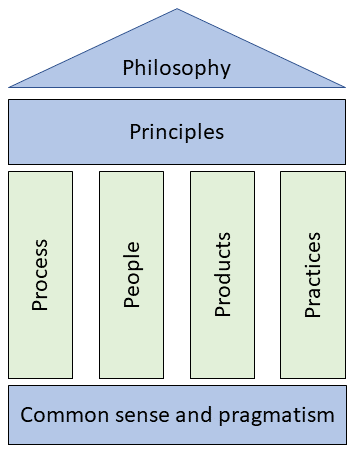
Overview
DSDM, or Dynamic Systems Development Method, is often considered a hidden gem within the Agile world.
Established in 1995, DSDM holds the distinction of being the earliest Agile methodology. It also stands alone as the only Agile method centered on managing Agile projects.
After the year 2000, DSDM emerged as a preferred Agile approach for software developers who were seeking alternatives to rapid application development (RAD) methods. A major issue with RAD was its inability to scale effectively for team collaboration. DSDM addressed this by facilitating teamwork and scalability, making it one of the first Agile methodologies adopted by the software development community.
DSDM played a part in the creation of the Agile Alliance and the Agile Manifesto in 2001. Its philosophy and principles influenced the Manifesto for Agile Software Development, although DSDM extends the Agile concept beyond just software.
In essence, DSDM embodied Agile before Agile was a recognized term!
DSDM Atern Evolution
In 2007, a notable update was made to the DSDM methodology, resulting in DSDM Atern. The name ‘Atern’ was derived from the Arctic Tern, a bird known for its highly collaborative nature and ability to cover vast distances. This served as an apt metaphor for the rebranding of the DSDM method.
By 2014, another update to the method was necessary due to confusion surrounding the term ‘Atern.’ It was decided to revert to the original name, DSDM, as it was the brand that everyone recognized. Consequently, DSDM and DSDM Atern now hold the same meaning!
DSDM Agile Project Framework
The 2014 rebranding of DSDM included the introduction of the Agile Project Framework. The DSDM Agile Project Framework is now the premier, tested, agile approach that caters to the dual requirements of modern organizations: governance and rigor, as well as agility and adaptability.
DSDM’s Agile Project Framework assists organizations in tackling common project issues such as delayed delivery, budget overruns, or unsuitable final deliverables.
Agile Project Management (AgilePM)
DSDM was the pioneer in integrating agile project management capabilities into an agile framework. Unlike Scrum, which solely concentrates on product delivery during an iteration, DSDM also emphasizes project management aspects. This distinction sets DSDM apart from most other agile frameworks.
Owing to DSDM’s versatility in addressing various agile requirements, it was selected as the foundation for the rapidly expanding AgilePM (Agile Project Management) qualifications, accredited by APMG International and the Agile Business Consortium.
DSDM – Pioneering Agile Methodology
DSDM is an iterative agile framework originally designed to execute software projects more effectively. Like other agile frameworks and methodologies, DSDM arose as an alternative to the challenging waterfall processes that had become widespread in the software development industry during the late 20th century.
DSDM’s Maturation
DSDM is now maturing as agile methodologies come of age. This maturation is attributed to organizations requiring more rigor and control when implementing agile in scenarios where the ‘ideal agile environment’ is not present.
DSDM is an agile method that caters to both simple product development projects with co-located teams and more complex projects involving multiple distributed teams across different countries and time zones. DSDM can scale up to handle multiple teams working in dispersed environments, something that scaled agile frameworks have only recently started providing.
DSDM Facts
Beyond IT Focus
While DSDM’s heritage, like most agile frameworks and methods, is rooted in the software development industry, agile has evolved over the past decade and is no longer exclusive to IT.
DSDM can easily be applied to projects beyond software development. In fact, it can be utilized in any type of product development project. By delivering a functional product incrementally at the end of each timebox, DSDM can provide business value early in the product development lifecycle.
DSDM: Standalone or Combined
The DSDM Agile Project Framework can be used either as a standalone method or combined with other well-known project management methods such as PRINCE2, MSP, and PMI.
It is also ideal as a wrapper for more limited Agile approaches like Scrum, ensuring that the entire project lifecycle is addressed. DSDM also enables Scrum to be scaled up for use in more than just product development.
DSDM Structure

DSDM is an agile project framework that consists of several attributes:
- philosophy
- principles
- process
- people
- products
- practices
- pragmatism and common sense.
These attributes together support a philosophy of delivering business benefits as early as possible, ensuring the optimal return on investment (ROI) for an organization.
DSDM’s ‘levelheadedness and pragmatism’ might seem peculiar to some, but this flexibility allows DSDM to sidestep the dogmatic inclinations that can sometimes afflict other Agile approaches.
A core conviction of DSDM is that nothing is built perfectly on the first try. As a general principle, 80% of a solution’s value can be delivered for 20% of the effort required to produce the entire solution.
By prioritizing the business need, DSDM supports projects that strategically align with an organization’s change portfolio.
DSDM Principles
DSDM consists of 8 principles that embody its ethos, culture, and way of working. These principles must be actively managed throughout a project, as compromising a principle may pose a risk to the successful execution and completion of the project.
DSDM adheres closely to agile principles, emphasizing delivery, effective communication, collaboration, and continuous delivery. All DSDM principles help align DSDM practices with the agile philosophy.
Understanding the guiding principles of DSDM is essential if you plan to take an agile project management course like AgilePM®, which is based on the DSDM method.
We will now look at the 8 DSDM principles:
1. Focus on the business need
- Understand business priorities.
- Create a valid business case.
- Enable continuous business commitment.
Every decision taken during your project should be in harmony with the overall project aims. Projects are intended to be a means to a desired outcome, supporting long-term business objectives. Utilizing approaches such as MoSCoW and timeboxing aids in concentrating on providing what businesses need, exactly when they need it.
2. Deliver on time
- Use timeboxing.
- Focus on priorities.
- Predict deliveries.
Adhering to product delivery timeframes is often indispensable. To ensure regular deliveries, plan all timeboxes in advance. Despite features possibly varying, the delivery dates always need to stay fixed.
3. Cooperate and collaborate
- Promote stakeholder collaboration.
- Focus on team building.
- Work with business representatives.
Teams must be adept at working collaboratively and making choices that benefit the people they represent. Embed subject matter experts in your team to ensure that information is shared effectively. Stakeholders can impart their wisdom and experiences to the project teams through a series of regular workshops.
4. Never compromise quality
- Set quality level at the start.
- Ensure quality doesn’t vary.
- Document and test.
The quality level to be attained is determined at the outset. All tasks should strive to reach this established standard. Test outputs promptly and engage in continuous evaluation.
5. Build incrementally
- Deliver business benefit early.
- Reassess priorities with each iteration.
- Confirm that the work is correct.
DSDM emphasizes that teams should comprehend the business issue’s scope prior to initiating development. Avoid delving so deeply into requirements analysis that it hinders development progress.
6. Develop iteratively
- Use customer feedback.
- Create Enough Design Up Front (EDUP).
- Evolve and be creative.
Iterative delivery is central to DSDM. Recognize that it’s uncommon for something to be flawless from the start, and be prepared to adapt within your project to achieve success.
7. Communicate continuously
- Manage expectations.
- Keep documentation simple.
- Interact through workshops.
Promote team engagement by conducting stand-ups and workshops. Share your work frequently using models and prototypes. Continuously foster informal, in-person conversations within the team.
8. Demonstrate control
- Be proactive.
- Timebox work and review regularly.
- Evaluate project viability.
Strengthen project management by making plans and progress accessible to everyone. Conduct formal documentation practices. Gauge your progress on the basis of products delivered, not tasks completed.
Processes
DSDM is characterized by both iterative and incremental approaches. The most crucial business requirements are delivered early, while less important ones are delivered later.
With its iterative nature, DSDM allows business representatives to view a developing solution, offer feedback, and request changes during its ongoing development.
Phases
DSDM’s process model consists of 6 phases. A pre-project phase and post-project phase set it apart from many other Agile methodologies that focus solely on delivery.
The DSDM phases are:
- Pre-project.
- Feasibility.
- Foundations.
- Evolutionary development.
- Deployment.
- Post-project.
People
DSDM encompasses individuals from both the business and development areas during the iterative and incremental progression.
Everyone involved in a project is assigned clear roles and accountabilities, and they collaborate within timeboxes to keep the project on course.
In contrast to other Agile techniques, DSDM specifies the project manager’s responsibilities.
Practices
DSDM suggests 4 essential practices.
Timeboxing
Similar to various agile frameworks, DSDM organizes work into fixed time periods (timeboxes), comparable to sprints in Scrum. The goal is to provide a functional product at the conclusion of each iteration (timebox). As a result, DSDM is both an incremental and iterative approach to product development.
Facilitated workshops
Facilitated workshops assemble project stakeholders to cooperate in defining business requirements and fostering mutual comprehension.
Modelling and iterative development
Modelling enables team members to visualize a business domain and enhance their understanding of it. Modelling assists in creating graphical representations of particular aspects of the system or business area being developed.
To deliver a working software increment at the end of each iteration, DSDM relies on a brief feedback loop with the customer. It recommends using the MoSCoW prioritization technique to determine the requirements for the team to work on during a timebox. Requirements are typically captured as user stories.
DSDM also employs prototyping, aiming to build quickly, obtain feedback promptly, and identify issues sooner rather than later. The fundamental DSDM philosophy is that it’s preferable to discover and address problems as early as possible.
MoSCoW prioritization
The MoSCoW prioritization method assists businesses in prioritizing requirements by identifying Must have, Should have, Could have, and Won’t have requirements for each timebox.
Contrasting DSDM and Scrum
A common misconception within the Agile community is that Scrum is a project management approach. However, Scrum is actually a development methodology that promotes team collaboration on both project and non-project activities to iteratively create valuable products for customers.
Scrum does not address the processes preceding a project (pre-project) or following the deployment of a solution (post-project). The pre-project phase involves evaluating the project’s value, while the post-project phase focuses on assessing the solution’s benefits and identifying any required enhancements.
In contrast, DSDM encompasses the pre-project and post-project stages and clarifies the project manager’s obligations. DSDM acts as an agile project management framework, while Scrum functions as a product delivery framework. Scrum can be utilized within DSDM projects during the remaining four project stages.
DSDM infographic
The following infographic shows the DSDM principles in greater detail.

Summary
The DSDM Agile Project Framework boasts a proven track record as a reliable approach to agile project delivery. It has been employed with great success in countless projects across the globe.
To date, DSDM remains the sole agile project management framework.
DSDM consistently demonstrates its capacity to work effectively within and alongside established corporate processes.
Since 1994, its application in both IT and non-IT projects has led to significant productivity gains, which have been independently validated by the UK Software Metrics Association.
For further details on how DSDM can enhance your Agile project delivery, or for information about agile project management training, please get in touch with us at agileKRC.
agileKRC has helped shape agile thinking by leading the teams that developed AgilePM® and PRINCE2 Agile®. We take a practical, success-oriented approach. We begin by taking the time to listen and understand your needs, before offering our real-world experience and expert guidance.













